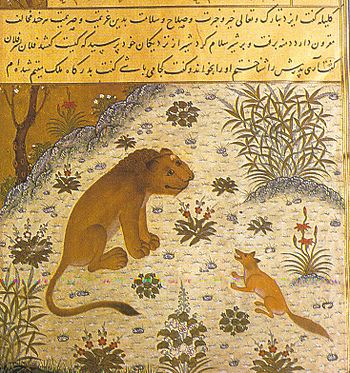The Deer without a Heart facts for kids
The Deer without a Heart is a very old story, also known as a fable. People often say it was first told by Aesop, a famous storyteller from ancient Greece. This fable is about a clever fox and a deer (or sometimes a donkey in stories from the East). The fox tricks the deer into visiting a sick lion not once, but twice!
After the lion catches and kills the deer, the fox secretly takes and eats the deer's heart. When the lion asks where the heart is, the fox cleverly says that an animal foolish enough to visit a lion's den couldn't possibly have had a heart. This part of the story shows an old belief that the heart was where thoughts and intelligence came from. This fable is a classic example of a trickster tale.
The Story from the East
In India, a similar story is found in a famous collection called the Panchatantra. In this version, a lion is sick and believes the only cure is to eat the ears and heart of a donkey. His servant, a jackal, convinces a donkey to come with him.
The lion is too weak to kill the donkey on the first try. So, the jackal has to trick the donkey into returning to the lion's den. After the lion finally kills the donkey, the jackal convinces the hungry lion to leave him alone with the dead animal. The jackal then quickly eats the donkey's ears and heart himself! When the lion asks about them, the jackal explains that such a silly animal couldn't have had ears to hear or a heart to think with.
This story traveled a long way, changing a bit as it was translated into different languages. It even reached Spain with Arab travelers. In some Arab versions, a donkey tries to charge a toll (a fee) to the lion and is killed for being so bold. The fox then eats the heart, saying it couldn't have been there in such a foolish animal. There are also Jewish versions where the donkey acts as a toll-keeper or asks for a fare on a ship.
The Story from the West
The tale of "The Lion, the Fox and the Deer" also appeared in ancient Greek writings. It was told by poets like Archilochus and later in a big collection by Babrius. In these stories, the fox tricks the deer twice into visiting a sick lion's home. The first time, the deer escapes with only an injured ear. The fox explains this injury as a rough friendly pat, and the deer, believing the fox, goes back to the lion and is killed.
Even in medieval Europe, similar stories were told. For example, in a version by Marie de France, the lion needs the deer's heart as a cure for its illness, just like in the Panchatantra version.
Another different version is found in "Fox Fables" by Berechiah ha-Nakdan. This story seems to be partly inspired by an old Latin poem. In that poem, a wild boar loses its ears as punishment for wandering into someone's fields and later dies. A thieving farmer explains the missing heart to his boss in the usual way. But in Berechiah's story, the wild boar trespasses in the royal lion's garden. After losing its ears and eyes as punishment, it is finally killed, and the fox steals its heart. These details show how different parts of the fable were combined over time.
Later, a Spanish version by Juan Ruiz tells of a musical donkey whose bad music keeps the lion awake. In this case, the donkey loses its heart and ears to a wolf.
The story continues to change even today. In a short film called The Stag without a Heart (2009/10) by Stuart Croft, the fox actually puts the stolen heart back into the deer. This is how the fox tricks the deer into returning to the lion again!


